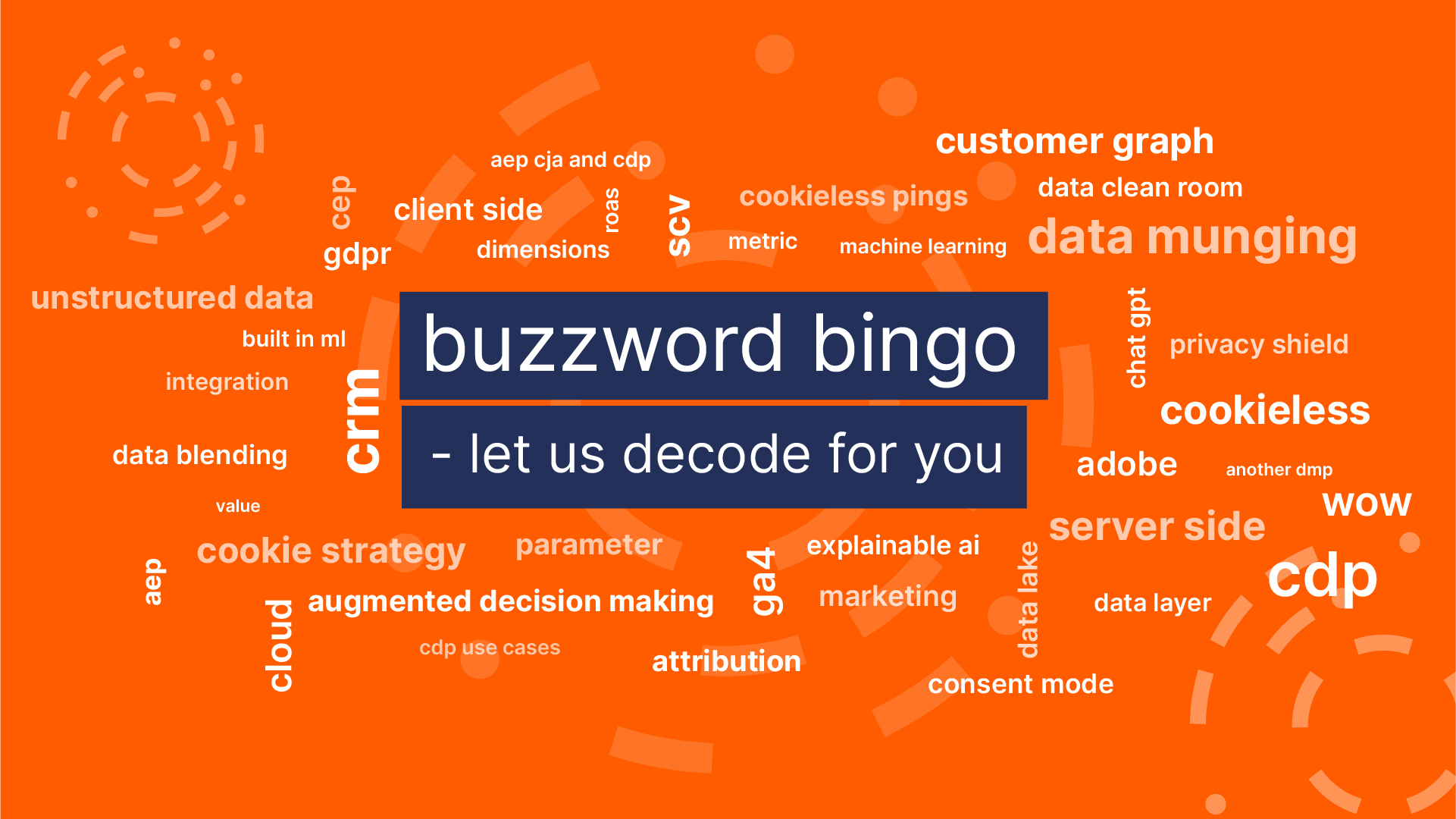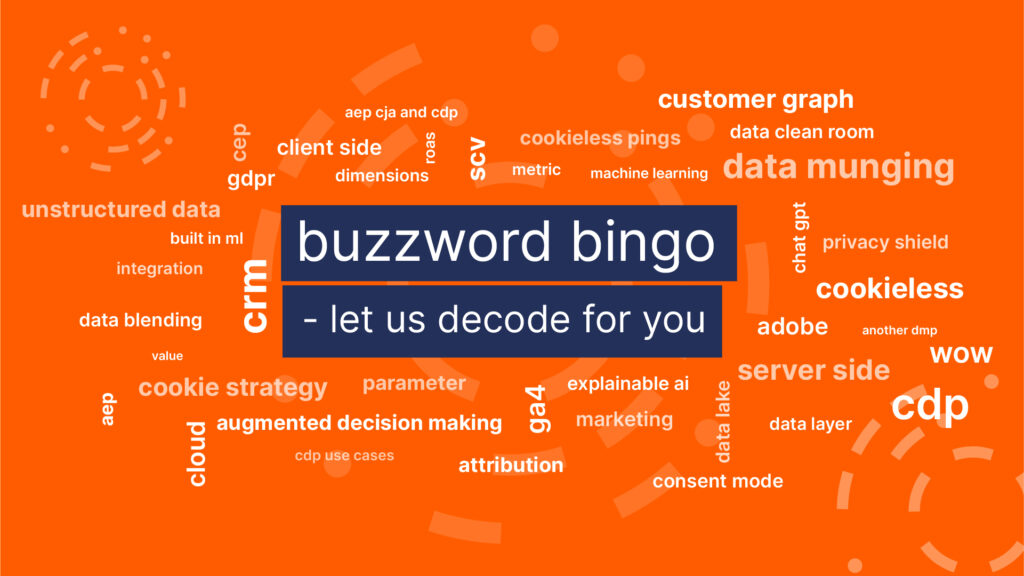Data Buzzwords: Deciphered

Ever attended a meeting where someone peppers their speech with acronyms you have never heard before? You wonder if the speaker has made a few terms up to make themselves sound more knowledgeable.
In the data analytics world, new buzzwords are created at such a dizzying pace that it can be hard to keep up for even the most technically minded, especially as meanings evolve over time. So, at Station10, we’ve developed a handy go-to terminology guide to promote a better understanding between professionals working in different roles across data analytics, marketing, and business. Is there a data buzzword or acronym that you would like us to add?
Adobe Analytics: software which provides reporting, visualisations, and analysis of customer data which enables users to discover actionable insights.
Adobe Experience Platform (AEP): A real-time customer data platform purpose-built to be used with all of Adobe’s Marketing Cloud products such as Adobe Analytics, Adobe Audience Manager and Target.
Attribution: the process of analysing customer touchpoints, such as paid ads and social media content, to determine how much each point is contributing to sales or conversions.
Augmented Decision Making: when AI proposes a decision, but the final decision to accept, reject or alter the recommendation is made by people.
Built-in ML: Machine Learning (ML – see later definition) is a powerful way of providing additional insight, without end users having to process and analyse the data themselves. Many software tools that use data (whether analytical tools or otherwise) incorporate machine learning methods to provide additional valuable services for their tools. These are therefore “built-in” to the tools; they can be somewhat unexplained, and can operate like a “black box”, so can need more detailed explanation.
CDP: A Customer Data Platform is a centralised database that collects and organises data from various sources to create comprehensive customer profiles. The database is accessible by other marketing systems. A CDP enables the development of highly targeted marketing campaigns.
CDP Use Cases: CDPs have a wide variety of business applications. Common use cases include personalisation of the customer journey, data integration and management, data privacy compliance, streamlining marketing functions, and enabling a Single Customer View (SCV).
CEP: Complex Event Processing is a method of collecting and analysing big streams of data to identify meaningful events – either opportunities or threats.
ChatGPT: AI language software that has a remarkable ability to answer questions and perform other complex tasks such as write essays, articles and code. Launched in November 2022 by OpenAI, ChatGPT (short for Chat Generative Pre-Trained Transformer) uses both supervised and reinforcement learning techniques.
Client-side: when the client’s browser is used to directly send data to a server during data collection or tracking. See also Server-side.
Cloud: the network of servers, software and databases that can be accessed remotely over the internet. Cloud computing is more flexible, scalable and cost-effective than traditional IT infrastructure.
Consent Mode: communicates your users’ website cookie consent status or app identifier consent status to Google. Consent mode receives your users’ consent choices from your cookie banner or widget and then adapts the behaviour of Google Analytics, Google Ads or third-party tags that create or read cookies accordingly.
Cookie: small units of data that a website places on a user’s computer to store information from a web browser session, for example, the user’s name and email address, or their browsing activity.
Cookieless: new marketing methods are being developed to circumvent increasing restrictions on third-party cookies, the small blocks of data that identify a user when they access a website.
Cookieless Ping: information sent to Google when a user refuses cookie consent.
Cookieless Tracking: a method of collecting some information about website visitors without storing user-identifiable data.
Cookie Strategy: A marketing strategy based around consumers’ online behaviour, as measured by website cookies.
Customer Identity Graph: A data map of how customers interact with a company website or its products, providing useful information for more targeted advertising and marketing.
Customer Journey Analytics (CJA): Analytics software built on the Adobe Experience Platform (AEP) which enables users to combine customer data from multiple channels to get better real-time insights.
CRM: Short for Customer Relationship Management, CRM is software that helps organisations more efficiently manage and improve their relationships with clients and prospective clients.
Data Blending: a process of combining data from multiple sources to create a single data set, enabling businesses to get greater value from their data in order to steer decision-making and strategy.
Data Clean Room: a secure, protected environment where personal user data can be shared and analysed by two parties. Organisations such as Meta and Amazon use data clean rooms to share aggregated data with advertisers.
Data Integration: bringing together data from different sources to create a single dataset, with the aim of delivering more effective insights.
Data Lake: a storage place that holds massive amounts of raw data.
Data Layer: a virtual layer between your website and your tag management system.
Data Management Platform (DMP): software that collects and organises data from a variety of sources to build customer profiles and improve ad performance.
Data Munging: transforming raw data into a useable form. Also known as data wrangling.
Dimension: in a data analytics context, a dimension is a set of data attributes that relate to a business question; for example, customers or products.
Explainable AI (XAI): artificial intelligence programmed so that its decisions and decision-making processes are understandable to humans. Also known as Interpretable AI or Explainable Machine Learning (XML).

GDPR: The General Data Protection Regulation is a legal framework for data privacy and security in relation to people in the European Union. Billed as the toughest privacy and security law in the world, it imposes obligations on all organisations, regardless of where they are based, that target or collect EU-related data. The GDPR came into effect in 2018.
Google Analytics 4 (GA4): The newest version of Google Analytics, GA4 enables users to measure traffic and engagement across their websites and apps in order to gain usable customer insights. GA4 uses event-based rather than session-based data and includes privacy controls such as cookieless measurement, as well as behavioural and conversion modelling. GA4 will replace Universal Analytics from mid-2023.
Machine Learning (ML): a type of artificial intelligence which enables machines to become better at performing specific tasks over time. Mimicking the way that humans learn, machine learning relies on data from previous events to predict future outcomes.
Marketing: any activity an organisation undertakes to encourage interest in their products and services, including market research, analysis, advertising and audience segmentation.
Metric: a data point that can be used to understand a wider dataset more fully. Data metrics are the starting points for tracking business and marketing trends.
Parameter: a term used in statistical analysis to describe a number that relates to a whole population.
Privacy Shield: An agreement between the European Union and the United States adopted in 2016 which aimed to ensure data transfers to the US complied with European data protection standards. It was overturned by the European Court of Justice in 2020. A new EU-US data transfer agreement was proposed in 2022, and due to be implemented in 2023, with new intelligence gathering privacy measures.
ROAS: short for Return on Ad Spend, a marketing metric which measures how much revenue you earn per pound or dollar spent on an advertising campaign.
Server-side: Also called cloud delivery, server-side tracking is when a central cloud system is used to collect data and forward it to third-party platforms. See also Client-side.
Single Customer View (SCV): a method for gathering data about all your clients or prospects in one place, such as a profile page in a customer data platform (CDP), with the aim of gaining insights to improve customer relations. Also called a 360-degree or unified customer view.
Unstructured Data: information that is not organised in a structured data model, which means it is difficult to manage and store. This is usually text-heavy data.
WoW: While gamers will instantly think of World of Warcraft, WoW in data analysis means week-over-week, or how a variable changes from one week to the next. For example, 10% WoW growth in customer enquiries shows there were 10% more customer enquiries this week than the previous week.


